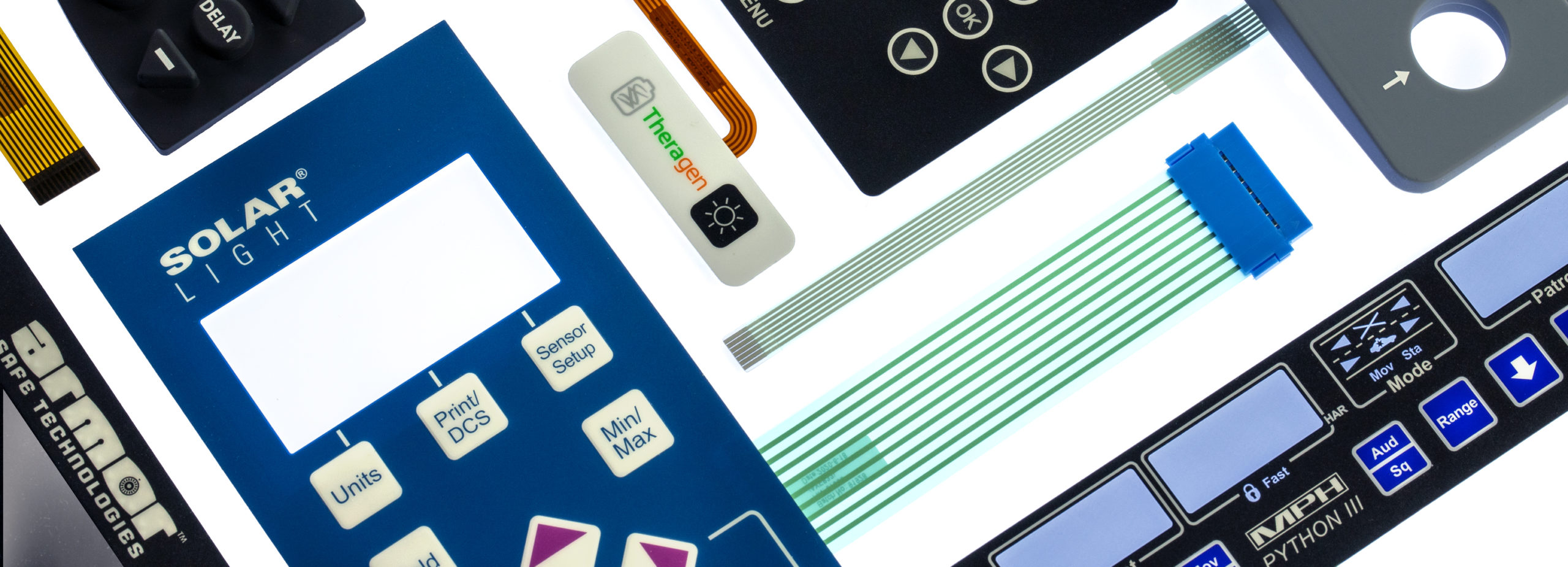The Influence of Membrane Switches on the Development of Smart Wearables
The Influence of Membrane Switches on the Development of Smart Wearables
Blog Article
Why Membrane Layer Switches Are Important for Long Lasting Control Solution
Membrane layer buttons play a pivotal role in guaranteeing the sturdiness and dependability of control systems throughout different sectors. Their special construction permits them to withstand challenging ecological elements such as moisture, temperature level extremes, and physical wear. This strength not only extends the life expectancy of the systems they offer yet also reduces maintenance demands. As we discover the multifaceted benefits of membrane switches, it ends up being evident that their relevance goes beyond simple capability, influencing individual experience and functional performance. What further implications do these qualities hold for the future of control system design?
Introduction of Membrane Layer Buttons
Membrane layer switches are versatile and trusted elements generally utilized in different electronic control systems. These buttons consist of several layers, consisting of a graphic overlay, a spacer layer, and a printed circuit layer. The graphic overlay provides both useful and visual layout, while the spacer layer makes certain that the buttons are activated only when pressed. The published circuit layer consists of conductive traces that complete an electrical circuit when the membrane layer is pressed, allowing the gadget to respond to individual inputs.
Membrane switches are frequently favored in applications needing a portable and light-weight style, making them excellent for handheld gadgets, clinical equipment, and commercial machinery. They can be tailored to meet particular customer needs and can include numerous functions such as backlighting, tactile feedback, and multiple shades. Membrane switches are resistant to dust, dampness, and contaminants, making them suitable for environments where longevity is essential.
Benefits of Longevity
In numerous applications, the sturdiness of membrane layer switches deals significant advantages that boost their general efficiency and integrity. These switches are created to stand up to severe environments, making them ideal for usage in requiring problems such as high moisture, severe temperatures, and exposure to chemicals. Their durable building assists to avoid damage from physical impact, ensuring durable functionality and decreasing the requirement for regular substitutes.
Additionally, membrane switches are resistant to deterioration, which is crucial in applications where regular interaction happens. This toughness equates to lower maintenance prices, as organizations gain from minimized downtime and less solution interruptions. In addition, the encapsulated layout of membrane changes safeguards internal elements from dust and moisture ingress, further adding to their lifespan.
One more benefit is their capacity to keep consistent performance gradually. With a high tolerance for mechanical anxiety, these switches protect their responsive responses and electrical integrity, making certain user complete satisfaction. Ultimately, the sturdiness of membrane layer switches not just improves functional performance yet additionally promotes confidence in their reliability, making them a recommended choice for control systems throughout different markets.
Applications in Numerous Industries
Durable control systems using membrane switches find comprehensive applications across a series of industries, his comment is here each profiting from the distinct attributes these buttons supply. In the medical sector, membrane buttons are essential for devices such as individual screens and analysis devices, where integrity and ease of cleansing are paramount. this page Their resistance to wetness and contaminants ensures they preserve performance in clean and sterile settings.
The automobile industry leverages membrane layer buttons for dashboard controls and infotainment systems, where they provide smooth, inconspicuous user interfaces that boost user experience. These buttons are also developed to hold up against severe conditions, consisting of exposure to extreme temperatures and vibrations.
In industrial settings, membrane buttons are frequently used in equipment control panels, using tactile responses and toughness needed for high-usage applications. Their capacity to resist chemicals makes them suitable for making settings where spills and contaminants are constant.

Consumer electronic devices, such as kitchen home appliances and push-button controls, also utilize membrane buttons for their convenience and cost-effectiveness. Generally, the adaptability and durable nature of membrane layer switches over make them essential throughout numerous markets, ensuring efficient operation and long life in control systems.
Layout and Visual Allure
While capability is vital, the style and visual charm of control systems outfitted with membrane layer buttons play an essential role in individual engagement and general experience (membrane switch). The visual layout of these buttons can considerably affect customer understanding and communication. A properly designed membrane layer button boosts the appearance of the device, making it more enticing to users and cultivating a connection in between the individual and the item
Membrane changes offer a terrific offer of versatility in design, permitting manufacturers to customize graphics, shades, and appearances to line up with brand name identification and item aesthetics. Using vivid colors and distinct patterns can draw interest, while responsive comments can enhance the user's interaction with the device. In addition, the capability to incorporate LED indicators and backlighting into the membrane button design provides both practical and visual benefits, enhancing exposure and usability in numerous atmospheres.

Enhancing User Experience

Additionally, membrane layer switches can be personalized to integrate visual interfaces, boosting use by providing details in a clear and intuitive fashion (membrane switch). This customization can consist of symbols, labels, and shade coding that guide customers via complex capabilities with convenience. In addition, their adaptability enables assimilation in various settings, making sure regular efficiency whether in industrial machinery or consumer electronics
The toughness of membrane buttons likewise plays an essential function in individual experience. By enduring extreme conditions and prolonged usage, these buttons reduce the likelihood of system failures, therefore promoting integrity and individual confidence. Ultimately, the tactical use membrane switches over not only elevates functionality however likewise substantially enhances customer communication with control systems, making them a crucial component in modern layout.
Verdict

Report this page